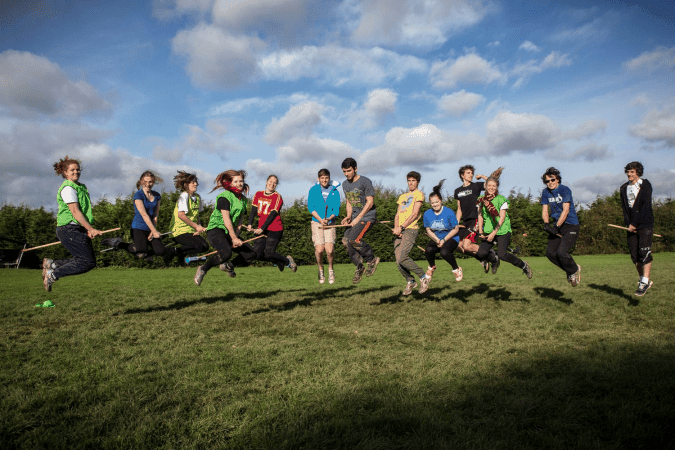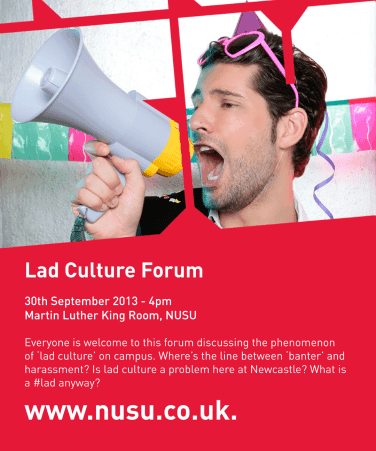(As with the previous offering I suspect I’m going to be challenged on much of what follows.)
Part I of these two pieces looked at the changes in the National Union of Students as it almost completely changed its campaign foci to concentrate much more directly on supporting students on local issues shifting from oppositionalism and international policy concerns, occasional leftist posturing to more direct positioning on student experience matters.
Changes in many students’ unions seem to have taken place in parallel to these developments and as universities across the country continue to adapt to the brave new fees-driven world, all are seeking to respond more to student demands as identified through, among other things, the National Student Survey and looking to NUS for support on such matters.
A recent piece in the Huffington Post suggested that at the same time as student activism had been supplanted by ‘lad culture’, students’ unions had failed too:
The decay isn’t only down to students. Student Unions are now anything but ‘Unions’. They are failing to protect the interest of students, nurture a hot bed of intellectual activity or help co-ordinate any meaningful student activism. Today, student unions are just shopping malls designed to extract money from the ‘student market’ and political apathy has made student democracy nothing more than a beautified popularity contest.
Are unions today really just shopping malls? Far from it. Whilst all unions have different characters, strongly conditioned by the local institutional context in which they operate, many have changed their approach in last decade or so from campaigning on external, national and international issues to being much more focused on the direct interests of students in their own institutions. Students’ unions have always had a slightly unusual relationship with their parent institutions as well – arguing and defending their independence fiercely while at the same time being inextricably intertwined with their host, which also provides the largest part of their funding.
A core role of unions is representing the student view to the university. Rather than revolution the consequences of student rebelliousness which ran from 1968 onwards resulted in much stronger representation on various university committees and this principle of representation has been sustained in all universities even across different governance models (within the UK).
However, representation in itself is insufficient. Having student members present at Senate and governing body meetings has arguably allowed universities to believe that this was the full extent of engagement with the union that was necessary. This can result in students’ unions being undervalued and having only superficial engagement with the university, largely confined to pitching up each year to argue for an incremental increase to the block grant. This is no longer adequate.
Another dimension of this lack of genuine engagement is the phenomenon of the naïve indulgence of the less productive examples of student behaviour, demonstrations, occupations and the like. This stems from a misguided and anachronistic 60s liberalism which views student campaigning activity as being just part of growing up (which of course it was for the overwhelmingly middle-class students of that time). However, this is really a failure to see the value and contemporary significance of the students’ union.
 A similar attitude is often seen in relation to union-run commercial activities, including bars, shops and catering outlets. This can all be happily ignored while such provision delivers good services to students and useful surpluses to the union. However, the last couple of decades have seen major changes in student social and drinking behaviour to which, by and large, students’ unions failed to respond until rather late in the day. The shift in student purchasing to off sales and decline in beer revenues meant that the cash cow, the traditional union bar, quickly turned into a dog and the failure to invest wisely during the good times left many unions exposed. Such services have to be run properly by professional staff. The idea that students should be permitted to “play” at managing services, catering, retail and bars as it is good training for them is just not sustainable, let alone in a time of austerity. Fortunately, many unions do now recognise this.
A similar attitude is often seen in relation to union-run commercial activities, including bars, shops and catering outlets. This can all be happily ignored while such provision delivers good services to students and useful surpluses to the union. However, the last couple of decades have seen major changes in student social and drinking behaviour to which, by and large, students’ unions failed to respond until rather late in the day. The shift in student purchasing to off sales and decline in beer revenues meant that the cash cow, the traditional union bar, quickly turned into a dog and the failure to invest wisely during the good times left many unions exposed. Such services have to be run properly by professional staff. The idea that students should be permitted to “play” at managing services, catering, retail and bars as it is good training for them is just not sustainable, let alone in a time of austerity. Fortunately, many unions do now recognise this.
Beyond representation and some commercial activities, unions have to continue to deliver their other core functions of providing for the wide range of social, political, sporting and cultural student societies and offering necessary support to students on academic, disciplinary and accommodation issues (for example). Universities need to work much more closely with their unions to ensure a joined up, comprehensive, high quality student experience. The issue is not protection of traditional domains, it’s about collaborating to provide the services and facilities students expect. This is not just about shops and bars but covers broader issues including induction, student support, employability, student volunteering and fundraising to name but a few.
Things aren’t always as straightforward for students’ unions as running shops and bars though. Students’ union officers don’t always know what their members think or indeed choose to represent only a minority opinion as they pursue an overtly political agenda. In addition, they are usually only around for a year, making relationship building something of a challenge. This is where it is crucial to have a much deeper engagement between university staff and those at all levels of the union. A vibrant, democratically active union, with full involvement of students in all fora, from staff:student liaison committees to Senate, and with able and engaged staff working closely with university professional services is much more able to cope with the odd year with a difficult president.
At the same time as the student movement has been reorienting to focus on teaching and learning issues there has been a structural realignment in the governance of students’ unions. The changes arising from the Charities Act, which necessitated separate arrangements from those of the parent university, have legally pushed institutions and Students’ Unions further apart. This makes collaboration and partnership between unions and universities all the more urgent and vital to ensure we have a shared understanding of our contributions to a high quality student experience. Working together is in the mutual interest of unions and universities. It needs to happen at every level, it needs a range of structures to make it happen as well as formal underpinning through some form of meaningful memorandum of agreement. However, there has to be trust, mutual confidence and sharing of expertise too, including in the co-ordination of delivery of effective student services. In addition, clear open communication channels are critical, and not just at times of crisis.

Too often it seems unions do have too strong a focus on catering for 18 year-old UK full-time undergraduates (there is some pandering to ‘lad culture’) and struggle to adapt to part-time, mature and international student groups. This is linked to the British youth drinking culture, the freshers’ week phenomenon (other countries seem to manage a transition period without an emphasis on alcohol) and sports club initiations (again often drink-fuelled). There are positive cultural features too including major fundraising efforts, lots of volunteering activity and a general commitment to promoting socially responsible behaviour by students. And whilst a student charter, setting out rights and responsibilities may look an appealing prospect in this consumerist age, without proper partnership between the university and the union it is never really going to get past fine words.
Unions and NUS do deserve credit for focusing more on the student experience, starting with this early report back in 2008 which covered everything from accommodation to quality of teaching and from personalization to student finance and employment. More recently NUS has worked with QAA to produce a series of research reports on different dimensions of the student experience. This has inevitably impacted on the approach students’ unions take to working with their members and universities.

Students’ unions have changed significantly in response to the radically altered higher education environment. although some of these changes are pushing unions and universities apart I believe is essential that we seek to counter this with greater convergence where possible. This depends on universities engaging properly at every level with their unions and recognising how important their contribution is to campus life and the student experience. In return, unions have to continue to engage seriously and consistently and recognise that there is significant common ground here. Whilst there will always be disagreements these should not perturb serious partnership working which is in the interest of the union, students and the university. These relationships were central to the analysis and recommendations Universities and their Unions (ISBN: 0 902683 78 0, LFHE, University of Warwick, 2006 Tom Bell, Paul Greatrix and Claire Horton) which sought to offer a set of pointers, suggestions, observations and comments and help universities and students’ unions to work together a bit better.
Students’ unions are more important and relevant to universities than they have ever been before. This is not because of the passing fancy of government or QAA but because meaningful student engagement is important to vital lively university life and a first rate student learning experience.
(Once again huge thanks to Aaron Porter for his extremely helpful comments on a draft of this piece.)














Interesting piece – as always. Just a few thoughts though. I am not sure whether many students’ unions regard their university as a ‘parent’ anymore. In my own research (shameless plug: http://www.bath.ac.uk/learningandteaching/student-engagement/qaa-student-engagement-project-2012-13.html) I’ve seen how much the relationship between institutions and their students’ unions has changed, particularly when the students’s union has matured in its ability to gauge student opinion, supports its representatives in dealing with the habits and politics of the governance structures effectively and has an absolutely sound elected representation system. By the time all this is in place, the relationship is hardly parental… Students’ union influence goes… Read more »